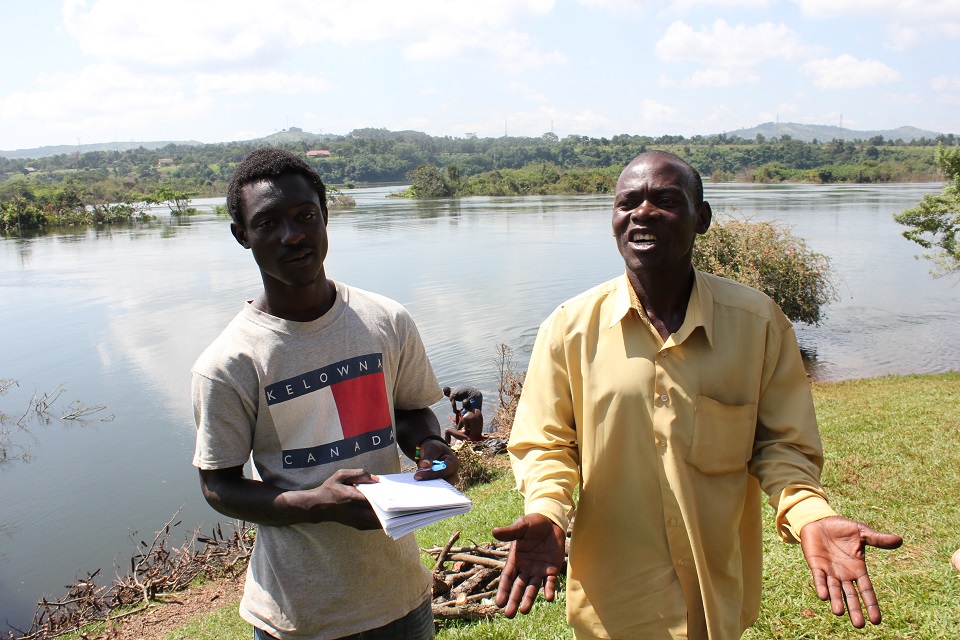
Mewu (25) og Hassan (35) livnærte seg som raftinginstruktører før elva ble til innsjø. Tidligere kunne de tjene mellom 50 000 (120 kr) og 70 000 (168 kr) om dagen. Nå tjener de mellom 30 000 (72 kr) og 50 000 omtrent tre dager i uka. Istedenfor rafting tar de med seg de få turistene som dukker opp på båttur på den nye dammen. De er ikke blitt kompensert for inntektstap. Foto: Anette Tjomsland.
Marian Willuhn
On April 7th 2016 the Norwegian state-owned hydropower company SN Power settled the terms upon which it will take up 50% of the shares of the Bujagali dam project in Uganda as it will buy out previous shareholder SGBH. The project will then be owned by SN Power, the Government of Uganda (GoU) and the Aga Khan Fund for Economic Development (AKFED). SN Power themselves claim that the Bujagali dam is a role model project and should serve as a blue-print on how to further conduct similar projects in emerging markets in Africa. In their press release the company notes that the dam has decreased energy costs in the East African state which up until completion of the dam was plagued by energy scarcity.
SN power being partly owned by Norfund has a distinct development mandate, which they themselves reiterate in their investment guidelines. The hydro-power giant called the project the “most successful public private partnership” and claims that its rationale is to ensure that the project continues to benefit Uganda.
The project in question has been in the focus of numerous NGOs due to its poor performance regarding human rights issues, environmental and sustainability concerns, a protracted construction phase with exploding costs and a falsely augured energy production.
The project is co-sponsored by the World Bank Group (WBG), the African Development Bank (ADB) and European Investment Bank (EIB). Subsequently rules of conduct apply and access to complaints mechanisms to people who have been affected by the project is granted.
Currently pending cases in this complaints mechanism include over 400 individual complaints regarding outstanding wages that have been lodged since 2007. The Compliance Advisory Ombudsman (CAO) and EIB find that the contractors and subcontractors responsible for building the dam failed to pay wages to hundreds of workers, some of which have been waiting for over 5 years for their money. The irresponsiveness of the GoU and the failure to live up to their responsibilities led the CAO to take their complaints procedure to the next step.
WBG and EIB found in their assessments that occupational safety and health standards have been violated, which led to injuries and disabilities. The affected workers have not been compensated for their disabilities. Here also the GoU has proven to be irresponsive to these allegations and the WBG is currently investigating these cases.
Furthermore, during the construction phase of the dam itself and its transmission line hundreds of cases concerning damaged land and property occurred. The building companies used blasting to proceed in the project which resulted in damaging living space of adjacent communities. Some of the buildings were “repaired” inappropriately and the residents allegedly tricked into signing documents they did not understand. The plaintiffs moved on to sue GoU, in its role as a co-owner of the project, in a class action law suit for damages on their properties. The High court of Uganda corroborated the evidence and ordered the GoU to pay compensations. However the dead line for compensation payment is almost a year overdue now, no payments have been made at this stage.
It is also to note with regret that pronounced commitments for compensation in resettlement have not been upheld. This comes from reports from the World Bank Group and the European Investment Bank likewise.
Lastly another complaint by a community of 200 people has been lodged. The plaintiffs argue that their cash crops have been destroyed as a result of the dam project and they never received compensation. The complaint is currently reviewed by the CAO.
The presumed positive effects for the business climate in Uganda have not manifested so far and are unlikely to do so according to EIB and the Ugandan Energy Minister. The immensely protracted building phase and the subsequently exploding buildings costs have rendered the project less profitable than originally assumed. WBG and EIB in their individual assessments argue that the augured energy production suffered poor analysis and thus the financial premises of the project were calculated wrongly. These findings were made in 2009 before the dam was completed. Part of the wrong assumption included the energy production capacity of 250MW, since the plant now in operation produces between 140-160MW. The EIB explicitly pointed out that the project failed to meet the development target and deemed it a failure.
The facts of the reports put forward by FIVAS and other NGOs as well as the multitude of complaints lodged to the WBG, EIB and GoU let one conclude that this dam falls short of being a “blue-print” project for the development of Africa.
SN power itself lists commitments regarding human rights, corruption and environmental concerns as their core principles in investment guidelines. FIVAS asked SN Power to clarify their investment rationale and how they are going to address the aforementioned issues. A dialogue over this issue will be hold soon.

